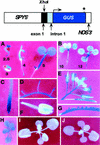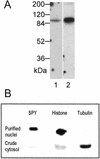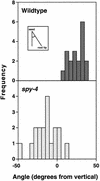SPINDLY is a nuclear-localized repressor of gibberellin signal transduction expressed throughout the plant
- PMID: 12068105
- PMCID: PMC161687
- DOI: 10.1104/pp.020002
SPINDLY is a nuclear-localized repressor of gibberellin signal transduction expressed throughout the plant
Abstract
SPY (SPINDLY) encodes a putative O-linked N-acetyl-glucosamine transferase that is genetically defined as a negatively acting component of the gibberellin (GA) signal transduction pathway. Analysis of Arabidopsis plants containing a SPY::GUS reporter gene reveals that SPY is expressed throughout the life of the plant and in most plant organs examined. In addition to being expressed in all organs where phenotypes due to spy mutations have been reported, SPY::GUS is expressed in the root. Examination of the roots of wild-type, spy, and gai plants revealed phenotypes indicating that SPY and GAI play a role in root development. A second SPY::GUS reporter gene lacking part of the SPY promoter was inactive, suggesting that sequences in the first exon and/or intron are required for detectable expression. Using both subcellular fractionation and visualization of a SPY-green fluorescent protein fusion protein that is able to rescue the spy mutant phenotype, the majority of SPY protein was shown to be present in the nucleus. This result is consistent with the nuclear localization of other components of the GA response pathway and suggests that SPY's role as a negative regulator of GA signaling involves interaction with other nuclear proteins and/or O-N-acetyl-glucosamine modification of these proteins.
Figures





Similar articles
-
Repressing a repressor: gibberellin-induced rapid reduction of the RGA protein in Arabidopsis.Plant Cell. 2001 Jul;13(7):1555-66. doi: 10.1105/tpc.010047. Plant Cell. 2001. PMID: 11449051 Free PMC article.
-
SPINDLY's role in the gibberellin response pathway.Symp Soc Exp Biol. 1998;51:73-8. Symp Soc Exp Biol. 1998. PMID: 10645426
-
SPINDLY, a negative regulator of gibberellic acid signaling, is involved in the plant abiotic stress response.Plant Physiol. 2011 Dec;157(4):1900-13. doi: 10.1104/pp.111.187302. Epub 2011 Oct 19. Plant Physiol. 2011. PMID: 22013217 Free PMC article.
-
Update on gibberellin signaling. A tale of the tall and the short.Plant Physiol. 2004 Jun;135(2):668-76. doi: 10.1104/pp.104.040279. Plant Physiol. 2004. PMID: 15208413 Free PMC article. Review. No abstract available.
-
Molecular mechanism of gibberellin signaling in plants.Annu Rev Plant Biol. 2004;55:197-223. doi: 10.1146/annurev.arplant.55.031903.141753. Annu Rev Plant Biol. 2004. PMID: 15377219 Review.
Cited by
-
SPINDLY mediates O-fucosylation of hundreds of proteins and sugar-dependent growth in Arabidopsis.Plant Cell. 2023 Apr 20;35(5):1318-1333. doi: 10.1093/plcell/koad023. Plant Cell. 2023. PMID: 36739885 Free PMC article.
-
Interplay between sugar and hormone signaling pathways modulate floral signal transduction.Front Genet. 2014 Aug 13;5:218. doi: 10.3389/fgene.2014.00218. eCollection 2014. Front Genet. 2014. PMID: 25165468 Free PMC article. Review.
-
Leaf development: a cellular perspective.Front Plant Sci. 2014 Jul 31;5:362. doi: 10.3389/fpls.2014.00362. eCollection 2014. Front Plant Sci. 2014. PMID: 25132838 Free PMC article. Review.
-
The Arabidopsis SLEEPY1 gene encodes a putative F-box subunit of an SCF E3 ubiquitin ligase.Plant Cell. 2003 May;15(5):1120-30. doi: 10.1105/tpc.010827. Plant Cell. 2003. PMID: 12724538 Free PMC article.
-
A tale of two sugars: O-GlcNAc and O-fucose orchestrate growth, development, and acclimation in plants.Trends Biochem Sci. 2025 Apr;50(4):332-343. doi: 10.1016/j.tibs.2025.01.003. Epub 2025 Feb 10. Trends Biochem Sci. 2025. PMID: 39934053 Review.
References
-
- Blatch GL, Lässle M. The tetratricopeptide repeat: a structural motif mediating protein-protein interactions. Bioessays. 1999;21:932–939. - PubMed
-
- Chiu W-l, Niwa Y, Zeng W, Hirano T, Kobayashi H, Sheen J. Engineered GFP as a vital reporter in plants. Curr Biol. 1996;6:325–330. - PubMed
-
- Coles JP, Phillips AL, Croker SJ, Garcia-Lepe R, Lewis MJ, Hedden P. Modification of gibberellin production and plant development in Arabidopsis by sense and antisense expression of gibberellin 20-oxidase genes. Plant J. 1999;17:547–556. - PubMed
-
- Comer FI, Hart GW. O-Glycosylation of nuclear and cytosolic proteins. J Biol Chem. 2000;275:29179–29182. - PubMed
Publication types
MeSH terms
Substances
LinkOut - more resources
Full Text Sources
Molecular Biology Databases

